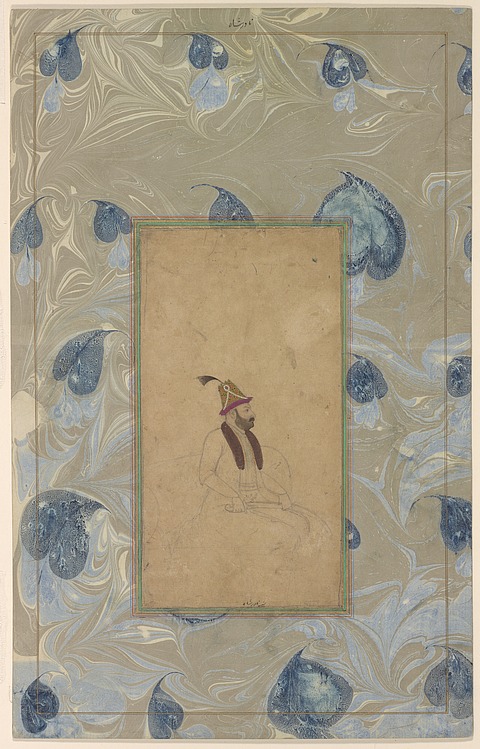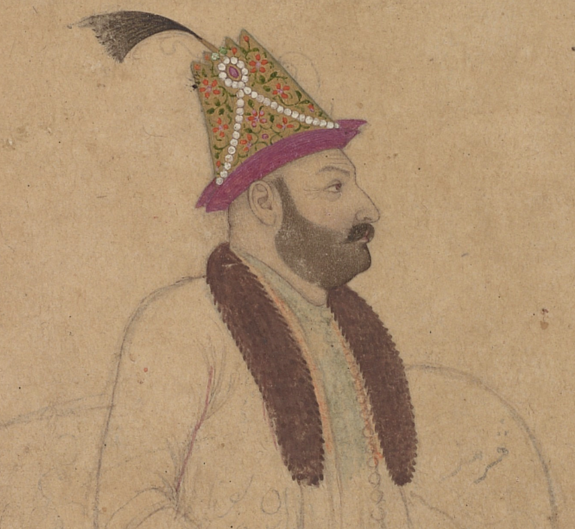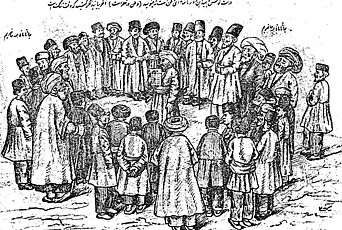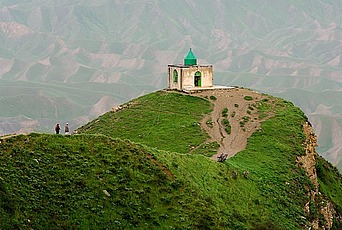Western—European and North American—historiography generally portrays the years between the death of Louis XIV in 1715 and the Congress of Vienna in 1815 as having given birth to the modern world—a republican world founded on rational discourse and popular sovereignty, an empirically grounded, industrializing world built on progress and productivity, an aggressive, market-driven world espousing expansion as agenda and organizing principle.
In the traditional interpretation of Islamic Middle Eastern history, the “eighteenth century” projects an entirely different image. Rather than evoking energy and innovation, it conjures up stasis, decline and defeat. It speaks of exhausted, mismanaged empires that either succumbed to regional competitors or proved too weak to resist the juggernaut of European imperialism. Examples abound. The state that had ruled Iran since the early sixteenth century, the Safavids, in 1722 collapsed under the onslaught of Afghan insurgents from the tribal periphery. The Ottomans, having failed to take Vienna in 1683, subsequently retreated against the Austrians and the Russians in the Balkans and later lost Egypt, first to the French and then to the Albanian warlord, Muhammad ‘Ali Pasha. In the Indian Subcontinent, meanwhile, the once mighty Mughal Empire disintegrated and was brought into the British orbit.
Iran was doubly disadvantaged in this process of “regression.” The Ottomans suffered defeat and lost territory yet maintained military, diplomatic and commercial contact with the nations of Western Europe, the source of most of what was new at the time. The so-called Tulip Period of the early eighteenth-century reflects a fascination with things European among the ruling classes of Istanbul. The Mughal state became tributary to the English East India Company and then was absorbed into the expanding British Empire. Yet that same process caused its elite gradually to become familiar with the ways and means of the new colonizers, creating models and generating ideas that helped the country keep in touch with developments in the wider world.
Iran, by contrast, in this period not just fell precipitously from stability to chaos, but in the process it became disconnected from the world in ways not experienced by the other “gunpowder empires.” Until the late seventeenth century the Safavids had been roughly on par with the Ottomans and the Mughals in their projection of wealth, power and cultural prestige. Sophisticated Europeans knew Iran as the legendary land of the Sophy, a term personified by the most dynamic ruler of the dynasty, Shah ‘Abbas I (r. 1587–1629). Shah ‘Abbas had connected his country to the world in unprecedented ways. After proclaiming Isfahan his capital and endowing it with a newly designed awe-inspiring center, he had turned this centrally located city into a nexus of trade links between Europe, the Ottoman Empire, Russia, and India—and a favored destination for European traders and travelers, who saw in it a latter-day reflection of the Persian Empire as they imagined it from reading Herodotus, Strabo, and Pliny.
All this energy and efflorescence had come crashing down with the fall of Isfahan in 1722. The Afghan tribesmen who brought down the Safavid state failed to build their own on its ruins and were soon swept aside. What followed was seventy-five years of chaos and anarchy during which the Iranian plateau became remote and forbidding territory, run by warlords and mostly shunned by Westerners. As the world was radically reconfigured in this period, Iranians continued to live in a rather self-congratulatory, inward-looking mode, secure in the knowledge that their country was, if no longer the center of the world, a place of consequence. In reality, Iran in this period rapidly “retreated” from the global scene as its ties with the outside world diminished in frequency and intensity. Iran’s short “eighteenth century,” the roughly seventy-five years that separate the fall of the Safavids from the rise of the Qajars, thus runs contrary to the perceived “global eighteenth century” and its presumed new level of (elite) connectivity.
This relative insularity was shattered in the early nineteenth century as the newly acceded Qajar regime (r. 1796–1925) with its largely tribally organized and poorly disciplined army suffered several terrible defeats against the well-equipped Russians, people the Iranians had always thought of and dismissed as bibulous, thick-skulled barbarians. As the Russians occupied large swaths of Iranian territory in the north—much of the southern Caucasus, comprising the modern countries of Armenia, Georgia, and Azerbaijan—the British intruded from the other side, the Persian Gulf.
Historians of late have turned away from this type of narrative with its focus on a golden age followed by decline and on great rulers and their deeds as organizing principles, to call for contingency, indeterminacy and attention to the common man. Yet, modern nationalism demands linearity and purposefulness, and shows little patience for revisionist complication. Faced with the flux and reflux of history, nationalism likes to tell a story of loss and regeneration through resilience, of foreign-inflicted defeat followed by phoenix-like resurgence. It is therefore hardly surprising that modern Iranian historiography—and certainly the Iranian popular imagination—tends to portray the Safavids and the Qajars in starkly contrasting terms—the first symbolizing pride and glory, the second representing fecklessness and submissiveness. Iranians have come to look back at the Safavid period nostalgically, as the last time their country was proud, independent, and the envy of the world. The Qajars, by contrast, the dynasty that would bring the country to the threshold of the modern age, count as spineless, corrupt rulers who blithely led the country into defeat and humiliation at the hand of foreigners, and who facilitated the country’s creeping incorporation into a Western-dominated imperialist network, preventing it from regaining its “natural” greatness.
The period in between is not so easily classified, for it seems neither a glorious moment in national history nor a century of potential splendor snatched away by foreign powers. Dark, seemingly directionless, and relatively short on written sources, the eighteenth century in Iranian history remains an awkward interlude. Modern Iranian historians have nevertheless sought to weave this period into a continuous national narrative by adopting a Carlylean “great man” view of history, highlighting the stature of the two rulers who created identifiable albeit short-lived states and thus present a semblance of coherence and direction to Iranian history in an otherwise tumultuous period: Nader Shah (r. 1736–47) and Karim Khan Zand (r. 1763–69). Both stand out, not just as the only two rulers who defied the period’s centrifugal forces, but as national heroes who revived Iran’s genius. The first, a brilliant warrior, redeemed the nation by restoring the honor it had lost with the fall of Isfahan to foreign tribesmen. The second represents the quintessentially Iranian search for justice.
The first also stirred the Western imagination in ways the second never did—especially after he marched into India in 1739, ransacked Delhi and returned home with fabulous treasures. Indeed, the reception of Nader Shah in eighteenth-century Europe was as swift and dramatic as it was complex. The image it created, half brutal warlord, half national liberator, would significantly contribute to the image modern Iranians would construct of him.
Nader Shah: Scourge of God or National Hero?
The portrayal of Nader in the eighteenth-century West was the combined outcome of eyewitness accounts, Persian-language sources, and Enlightenment anxieties. Europeans, still puzzled by the sudden fall of the Safavids, learned of him even before he took power in 1736 as the warrior who reconquered Isfahan from the Afghans in 1729. The Mercure de France of November 1731 contained an “eyewitness report” that portrayed Tahmasp Quli Khan, as Nader Shah was still called at the time, as a savior, a man of valor and fidelity, brave and full of esprit. His stature as the dynamic warlord who might rescue his nation by liberating it from the barbarians who had invaded this old, sophisticated land—the Afghans, the Ottomans, and the Russians—only grew with time. In 1738 a huge tome appeared in Germany depicting Nader as the divinely inspired savior of a collapsed nation. The notion of Nader the savior resonated with the political philosophy of the Enlightenment as articulated by Montesquieu, Diderot and Holbach, who distinguished between the legitimate right to defend and recover one’s home country, and illegitimate wars of conquest.
A rather different Nader burst onto the European scene soon thereafter, with his defeat of the Mughal Emperor Mohammad Shah at Karnal in 1739 and his subsequent sack of Delhi. News of these exploits spread quickly, carried by missionaries and agents of the European maritime companies, and soon gave rise to numerous pamphlets and books. The earliest narrative about Nader’s Indian exploits seems to have been a report written in 1739 by Dutch East India Company agents in Bengal. Published in Holland in 1740, this report may have been the source of the anonymous two-volume work that came out in Amsterdam a year later as Histoire de Thamas Kouli-Kan Sophi de Perse, a text that subsequently was translated into English, Italian, and Spanish. In the next few years the Asian warlord was the subject of a number of articles in the British press, some of which have plausibly been attributed to Samuel Johnson. Two years later the Anglo-Saxon world became thoroughly acquainted with Nader through James Fraser’s History of Nader Shah, which was mostly based on reports by William Cockell, an agent of the English India Company who had served in Iran while Nader was in power. In the same year, 1742, James Spilman, a Russia Company merchant, published an account of a journey he had undertaken to Iran in 1739 and to which was appended a brief account of the rise of Nader Shah. In 1743 André de Claustre published Histoire de Thamas Kouli-Kan, roi de Perse. A generation later the French reading public was reminded of Nader through the translation the famous Orientalist William Jones made of a Persian chronicle written in Nader Shah’s orbit, Mirza Mohammad Mahdi Astarabadi’s Tarikh-e Naderi.
A fictionalized Nader quickly followed. The first novel—in which a young Swiss man sets out on an Asian adventure that includes his participation in Nader’s Indian campaign—appeared in 1754. A second, presented as the memoirs of Shah Tahmasp II, Nader’s protégé until he deposed him, followed in 1758. Both reflect the spirit of a relatively pacific European age in search of a heroic cause in their portrayal of young, poor, and intelligent men who in Europe find no outlet for their martial inclinations. They also reflect the prevailing notion that the East, unfettered by feudal stratification, was open to talent. The same theme appears in the contemporaneous theatrical representation of Nader Shah in Holland, France, and Italy.
The way Nader was in Europe represented varied by context. In the Dutch setting, he became an emblem of republicanism, a “protagonist of lowly origins whose right to the throne sprang from his desire to serve his subjects.” Yet a more common theme in the earliest European references to him was the image of the disciplined warrior, the type Europe lacked until the appearance of Frederick the Great on the European scene in 1740.
As in the case of Alexander the Great, to whom he was sometimes likened, the more negative aspects of Nader’s career over time received ample attention as well. Several authors highlighted his rapaciousness and linked the vast treasure he bought back from India to the typical Oriental despot who plunders and hoards rather than builds. Nader’s cruelty and growing madness as the ultimate symbol of the descent into violence and cruelty of a land previously known for its humanism, tolerance and sophistication did not go unnoticed either. The English merchant-traveler Jonas Hanway, for instance, who in 1743 had visited Nader’s army camp, at once presented the ruler’s appearance as punishment for Iranian sloth and dissolution and painted a lurid portrait of a usurper driven by greed and brutality.
Contemporary Iranian sources evince a similar ambivalence. The chroniclers writing in Nader Shah’s immediate orbit naturally hedge their bets and defuse the ruler’s obvious ruthlessness and gathering madness by turning a blind eye to these uncomfortable facts or by blaming the victims. They generally portray Nader as a ruler of military virtue and sound lineage, hail him as a strongman who had restored order, and defend him against the indictment of having usurped power. The afore-mentioned Astarabadi set the tone for an enduring narrative by lauding Nader for expelling all foreign occupiers from Iranian soil. At pains to rationalize the ruler’s growing craziness and cruelty, he claimed that Nader changed only after his expedition to the Caucasus, eventually bringing ruin to his country.
As a new dynasty of questionable roots and legitimacy, the Qajars had to expunge the legacy of those who came before them—other than the Safavids, to whom they paid allegiance on account of the Shi‘i credentials they themselves so sorely lacked. Nader Shah was one of those. Agha Mohammad Khan, the founder of the Qajar dynasty and a ruthless warlord himself, chose to distance himself from Nader for having deviated from the Shi‘i foundations laid by the Safavids and invoked by Agha Mohammad Shah to buttress his own legitimacy. Yet the first Qajar ruler must have been impressed by his forebear as well, for he had two figures added to the two huge battle scenes adorning the walls of the Chehel Sotun palace in Isfahan, one of which represents Nader’s defeat of the Mughal Emperor Mohammad Khan at Karnal in 1739. Nader also figured in the one of the main halls of the Golestan palace that was built in the newly chosen capital Tehran and renovated in 1806—in a pose of returning the crown of India to the Mughal king.
A More Complex Nader Shah
The early nineteenth century saw two developments that helped shape a new or at least a more complex image of Nader Shah. The first was the string of humiliating military defeats the Qajars suffered against their most formidable enemies, the Russians. The second was the meteoric rise of Napoleon followed by a career that affected the world from the East Coast of the United States to the shores of the Indian Ocean.
The military weakness of the Qajars against the Russians and the tremendous loss of land their defeats entailed quickly detracted from the new dynasty’s aura and made the Iranian public long for a success story. A direct relationship can be discerned between these defeats and the continuing, indeed growing popularity of Nader Shah among Iranians, as exemplified in the more than fourteen editions that appeared of Astarabadi’s popular account of Nader’s life and exploits, the Jahan-gosha-ye Naderi.
The relationship between the reputation of Napoleon and that of Nader Shah in Iran—and Europe—seems something like a dialogic engagement: Napoleon saw himself as a latter-day Nader. Iranians, in turn, came to admire Napoleon as the strongman they themselves so sorely missed in the nineteenth century. Nader in due time and in good Orientalist fashion became known, first in Europe, then in Iran, as the Asian or Persian Napoleon; and, completing the cycle in an anti-Orientalist manner, Napoleon is now often called the European Nader Shah.
All indications are that Napoleon was greatly impressed with Nader Shah. It is almost certain that, as a young man, Napoleon read about Nader’s exploits, and it is likely that he identified with the story of a lad of humble origins who had risen to great heights through sheer will power and energy. His Asian dreams—his own search for a heroic cause—are neatly summed up in his famous exclamation before a group of bickering German princes in 1804 to the effect that Europe had no longer anything to offer ambitious men, that only in the Orient great prestige and wealth could be acquired. That Napoleon greatly admired Nader emerges from the record of Amédée Jaubert, the French Orientalist who in 1807 visited Iran to conclude a Franco-Iranian alliance. Jaubert carried a letter from Napoleon with him in which the French emperor, somewhat injudiciously in front of the rather sedentary Fath ‘Ali Shah, praised Nader Shah as a “great warrior, who was “able to conquer a great power,” who “struck the insurgents with terror and was fearsome to his neighbors, while he “triumphed over his enemies and reigned gloriously.” It is also surely no coincidence that ‘Askar Khan Afshar, Fath ‘Ali Shah’s envoy to Paris in 1808, presented a copy of the Jahangosha-ye Naderi to the Imperial Library in Paris when he came to Paris the following year. L’Histoire de Thamas Kouli-Kan, finally, was one of the books available to Napoleon during in years in exile on Saint Helena between 1815 and 1821.

Napoleon, in turn, made quite an impression in Iran—and a lasting one at that. He became and long remained a familiar figure in part because the country was part of his strategic vision, making him deal directly with its rulers by way of diplomacy. But the main reason for his enduring fame and popularity may have been the same as what made eighteenth-century Europeans look up to Nader Shah—because his strong character spoke to the imagination of the Iranians and projected something that they found missing in their own rulers. Mir ‘Abd al-Latif Khan Shushtari, an Iranian who seems to have imbibed some anti-French sentiments during his long stay in British India, nevertheless called Napoleon a leader who stood out for his organizational skills, his wisdom and his sophistication.
In Iran, meanwhile, the admiration for the French strongman was no less strong. John Malcolm, Britain’s first ambassador to Iran and the author of the first modern history of the country, relates how in 1810, Napoleon’s “name was familiar to numbers in Persia, and some few understood the character of his power.” An “old friend” of his, a poet and a philosopher, told Malcolm that, in his opinion, “this Buonaparte…is a wonderful man; he wields empires as if they were clubs.” Speculating that, after coming to terms with the Ottomans, this Western Chengiz Khan might take on Iran and Russia and then, “make use of both to overthrow your [British] power in India.”
Other Iranian officials were great admirers of Napoleon as well. ‘Abbas Mirza (1789–1833), crown prince, governor of Azerbaijan and Iran’s first modern reformer, was one. His newly constructed royal summer palace at Ujan near Soltaniya was decorated with four paintings, two of which represented the Russian Tsar, Alexander I, and Napoleon respectively. Another one was Hajji Baba, a “prince” in Hamadan who, when Robert Cotton Money met him in 1824, “asked all about Napoleon,” and collected “all the anecdotes he could of him” because he seemed to adore his character. The third Qajar shah, Mohammad Shah (r. 1834-48) had his palace in Tehran “hung round with various prints of Napoleon, Prince Albert and Queen Victoria.” Mohammad Shah is said to have been interested in acquiring a copy of the Life of Napoleon, with engravings of the emperor’s battles, and he ordered Mirza Reza Mohandes, who earlier had translated biographies of Peter I, Alexander the Great, and Charles XII into Persian, to produce a translation of a history of the French general, from an English rendering of an originally French work. Richard Khan, too, in 1869 translated A Brief History of Napoleon into Persian. In the early twentieth century ‘Abbas Mirza Salar Lashkar, a.k.a. Nayeb al-Saltana, picked up a book titled Napoleon Ier et la Perse and decided to translate it into Persian.
As noted, the revised image of Nader, from usurper and brutal tyrant to savior of the nation, was greatly facilitated by widespread Iranian disappointment with the feeble Qajars, and further built, in a dialectical way, on the analogy with Napoleon. James Morier, British envoy and the author of the picaresque novel, Hajji Baba of Isfahan, in 1808 said about the Iranians that, “of Bonaparte, from the likeness of that of their own Nadir Shah, they have a very high idea.” But the way in which the warlord was fashioned in the twentieth century was in some way a calque on the way Western authors and especially John Malcolm portrayed him. To Malcolm, Nader Shah was a force of nature, a brute who acted to purify the overripe, decadent civilization from which he himself sprang. Where the Polish Jesuit Thadeusz Krusinski, an eyewitness to the fall of Isfahan in 1722, had seen the Afghans as barbarians who might be civilized by becoming acquainted with Persia’s superior culture, Malcolm saw in Nader Shah a volcanic force that had rejuvenated that same culture precisely by ridding it of Afghan primitivism. Malcolm saw Nader the way Edward Gibbon had seen Attila the Hun: as a great warrior and disciplinarian who had cleansed the land by liberating his people from the yoke of barbarians. Full of admiration for Nader’s military prowess, Malcolm in a rather self-serving manner painted a redeeming portrait of the eighteenth-century empire builder, based on his anticipation of the unfolding of his own empire, that of the British. It is telling in this context that Malcolm did not dwell on the savagery that accompanied Nader’s subjugation of northern India and his sack of Delhi, thinking it greatly exaggerated. The bloodletting of the last few years of the warrior’s life he ascribed to creeping insanity.
Malcolm’s assessment would essentially offer the template for the later nationalist Iranian portrayal of Nader Shah. Of course, for this to have an impact on Iranian image making, Malcolm’s landmark book, A History of Persia (1815) first had to be translated into Persian. This might have happened as early as the 1840s were it not for Naser al-Din Shah’s grand vizier and chief counselor Mirza Taqi Khan, better known as Amir Kabir who, wary of Malcolm’s less than flattering verdict on the Qajar dynasty, is said to have cautioned his master that “for Persians reading such a book is fatally poisonous.” That does not seem to have deterred the monarch himself, for the shah apparently had A History of Persia read to him before going to sleep. At any rate, the acquaintance among the wider Iranian public with Malcolm’s take on Nader and Iranian history at large would have to wait until the 1870s, when a Persian translation of his book was undertaken. Yet the work that resulted did not come out in Iran but in British-controlled Bombay and in the context of the new type of print culture that had developed in India under British auspices. Over time, this translation would become exceedingly popular.
Nader Shah in Modern Iranian Historiography
The fall of the Qajars in the 1920s and the rise of Reza Khan, the founder of the Pahlavi dynasty, inaugurated a new phase in the dialectical process of historiography with regard to Nader Shah. British foreign secretary Victor Mallet in 1925 insisted that Nader Shah was Reza Khan’s “great hero,” adding that he would not be surprised if the new ruler would model his career on that of Nader. The Iranian press at the time depicted the new ruler accordingly, as a national savior ready to rebuild the country and drive out the foreign intruders. Just as the early Qajar historians had exorcised the previous regimes, including that of Nader, so the historians who came of age in the 1920s and 1930s followed the line of the new regime by decrying the stagnation and especially the loss of land their country had suffered because of the military weakness of the Qajars, which inevitably entailed a reevaluation of the last ruler who had stood for a strong and independent Iran—Nader Shah. In the 1930s, as Reza Shah consolidated his power, military history and the single strong leader came to the fore to help create a usable past for a state increasingly built on authoritarian foundations. For historians writing in the reign of Reza Shah and his centralizing tendencies, Nader’s military career acquired a heightened significance for having reunified the nation—just like Iran’s current ruler.
In modern times, Nader has remained controversial in Iran. To some, he was just an uncultured tribal chieftain who delivered the coup de grace to the magnificent Safavid state. In modern Iran, where the great man, the one who keeps order and who can bring salvation by effecting the kind of change that no one else is willing to take responsibility for, continues to loom large, Nader Shah remains a hero. “For many Iranians today, Nader’s military successes are justification in themselves and more than outweigh any brutalities that accompanied him.” Yet Nader remains an awkward fit for those who adhere to the dominant paradigm in modern Iranian history writing with its tendency to espouse a primordial nationalism that preaches an unbroken civilizational link between the Achaemenids and the Islamic Republic. For some he remains the warrior who restored Iran’s pride by driving out the foreigners who had occupied the country, the Afghans, the Ottomans, and the Russians. Yet the deeply ingrained notion that Iranian civilization is one of “givers” is hard to reconcile with the sheer brutality and the outright imperialism culminating in Nader’s Indian campaign, which consequently, à la Malcolm, has to be presented as an aberration in an otherwise brilliant career. Nader thus becomes the figure whose genius could have halted and even reversed the decline that had set in with the Afghan onslaught and the fall of the Safavids. In this scenario, after uniting Iran Nader could have done a lot to rebuild a great nation if he only he had cared about the welfare of the Iranian people. Instead, he lost his mind when he decided to invade India, and even the dividend of that campaign, a huge amount of treasure, was wasted.
A related yet slightly different interpretation connects Nader to the feeble awareness eighteenth-century Iranians evinced about the global changes and the sinister designs of foreigners on their country at the time. Nader, in this scenario, was too busy making war and thus did not take advantage of Western scientific and technological achievements and skills other than to seek European assistance in building a Persian-Gulf fleet—something the Safavids had never done. For all his military brilliance, he also had no eye for the imperialist schemes of the Europeans. Indeed, to some, he even facilitated their imperialist project by offering the English East India Company reduced customs rates and seeking their assistance in building naval capacity. Even his Indian expedition benefited the British. By bringing home fabulous wealth from his Delhi campaign he acted as Trojan horse, increasing their business opportunities, and by opening up and weakening India he enabled the English to expand their long-term influence and domination in the subcontinent.



